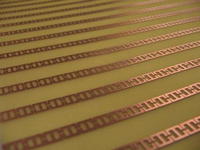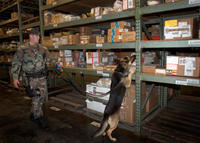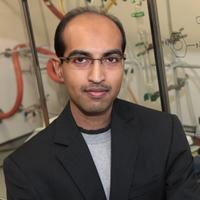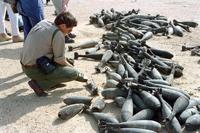-
June workshop on approaches to CBRNE incidents
NIST-organized workshop will explore ways to improve an all-of-government approach that increases resilience to international chemical, biological, radiological, nuclear, or explosive (CBRNE) incidents.
-
-
Arsenic in groundwater in Bangladesh naturally occurring
Human activities are not the primary cause of arsenic found in groundwater in Bangladesh. Instead, a team of researchers found that the arsenic in groundwater in the region is part of a natural process that predates any recent human activity, such as intensive pumping.
-
-
Keeping an eye on the world’s dangerous chemicals
In the chemistry labs of the developing world, it is not uncommon to find containers, forgotten on shelves, with only vague clues to their origins. The label, if there is one, is rubbed away. Left alone for years, some chemicals can quietly break down into explosive elixirs, and what was once an innocent experiment by a well-meaning scientist becomes a very real, unsecured threat. Should such chemicals fall into malicious hands, the consequences could be widespread and deadly.
-
-
Metamaterial sensor improves security, collision avoidance

Engineers have developed a novel sensor which is more efficient, versatile, and cheaper for potential use in such applications as airport security scanners and collision avoidance systems for aircraft, cars, or maritime vessels.
-
-
Neutralizing the effects of lethal chemical agents
Organophosphorus agents (OPs) are used both in farm pesticides, and by terrorists and rogue states. About 200,000 people die each year across the world from organophosphorus agents (OP) poisoning, through occupational exposure, unintentional use, and misuse, mostly in developing countries like India, Pakistan, and Sri Lanka and through deliberate terrorist activities. OPs include compounds like Tabun, which was developed in 1936 by German scientists during the Second World War, Sarin, Soman, Cyclosarin, VX, and VR. Researchers develop an enzyme treatment which could neutralize the effects of OPs.
-
-
Syrian rebels trained in handling, securing chemical weapons

The United States and some of its European have issues contracts to defense contractors to train Syrian rebels on how to identify, handle, and secure chemical weapons stockpiles in Syria; some of the training is done in Jordan, but some of the contractors are already inside Syria, where they, and U.S. intelligence operatives, are working closely with friendly rebel groups to monitor Syria’s chemical weapons production and storage sites
-
-
Detection aircraft surveys 600 miles of PG&E California pipeline for gas leaks
PG&E’s transmission pipeline is routinely surveyed each year, typically by ground crews; accessing rural areas with difficult terrain, however, can be time consuming, expensive, and unsafe for crews on the ground; aerial surveys often look for dead vegetation as an indicator of gas leaks
-
-
Improved technology to detect hazardous chemicals
Scientists have developed a system quickly to detect trace amounts of illegal drugs, explosives, pollutants in rivers, or nerve gases released into the air; the new system can pick out a single target molecule from 10,000 trillion water molecules within milliseconds, by trapping it on a self-assembling single layer of gold nanoparticles
-
-
Nanotech detection device emulates dog's nose to detect explosives

Inspired by the biology of canine scent receptors, scientists develop a chip capable of quickly identifying trace amounts of vapor molecules; the chip is part of a device which is both highly sensitive to trace amounts of certain vapor molecules, and able to tell a specific substance apart from similar molecules
-
-
New methods might drastically reduce the costs of investigating polluted sites
In Europe there are over 20,000 complex and large contaminated areas. These so-called megasites threaten scarce land and water resources, create environmental and health risks, and result in economic and social costs; new methods may allow polluted sites to be investigated and monitored long term at significantly reduced costs
-
-
Keystone XL pipeline: reliability of remote oil-spill sensors questioned
The oil industry plans to build thousands of miles of pipelines in the next five years, making leak detection a growing issue; many of the new pipelines will cross aquifers and rivers which are used for drinking water and irrigation; the Keystone XL pipeline has already experienced its share of controversies, and now there is a debate over the quality and reliability of the pipeline’s sensor system for remote detection of oil spills
-
-
Removing toxins from the environment

A Florida State University chemist’s work could lead to big improvements in our ability to detect and eliminate specific toxic substances in our environment; the novel approach is based on stripping electrons from the toxic chemical known as fluoride; in addition to toxin removal, the approach has many other applications
-
-
Electronic nose detects airborne toxins down to the parts per billion level
Research create an electronic nose device with applications in agriculture, industry, homeland security, and the military; the device can detect small quantities of harmful airborne substances
-
-
U.K. to help IRAQ destroy legacy chemical weapons

U.K. scientists will provide training which will support the Iraqi government’s efforts to dispose of remnants of the chemical weapons amassed during Saddam Hussein’s regime
-
-
Resolving mystery odor alarms
In the post-9/11, security-conscious era, unidentified odor often cause the precautionary evacuation of buildings, airport terminals, and more; a New Jersey company offers an educational video on the problem of mystery odors – and offers odor identification services to help identify and resolve mystery odor complaints
-
- All
- Regional
- Water
- Biometrics
- Borders/Immig
- Business
- Cybersecurity
- Detection
- Disasters
- Government
- Infrastructure
- International
- Public health
- Public Safety
- Communication interoperabillity
- Emergency services
- Emergency medical services
- Fire
- First response
- IEDs
- Law Enforcement
- Law Enforcement Technology
- Military technology
- Nonlethal weapons
- Nuclear weapons
- Personal protection equipment
- Police
- Notification /alert systems
- Situational awareness
- Weapons systems
- Sci-Tech
- Sector Reports
- Surveillance
- Transportation
Advertising & Marketing: advertise@newswirepubs.com
Editorial: editor@newswirepubs.com
General: info@newswirepubs.com
2010-2011 © News Wire Publications, LLC News Wire Publications, LLC
220 Old Country Road | Suite 200 | Mineola | New York | 11501
Permissions and Policies
Editorial: editor@newswirepubs.com
General: info@newswirepubs.com
2010-2011 © News Wire Publications, LLC News Wire Publications, LLC
220 Old Country Road | Suite 200 | Mineola | New York | 11501
Permissions and Policies
